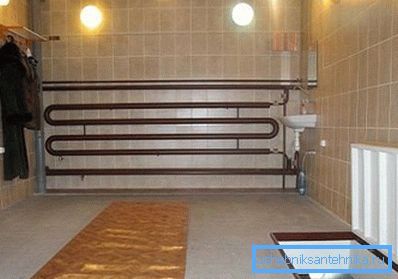Heating registers: production methods, types, calculation of
How are heating registers made of smooth pipes? What are they like? When is the use of these heaters justified? Finally, how to calculate the register - the heating must correspond to the characteristics of the room, right? Let's try to answer these questions.
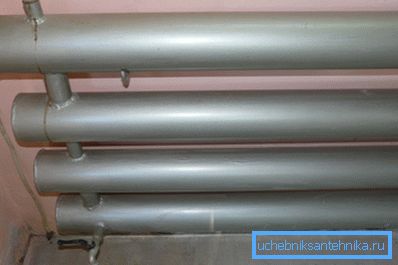
What it is
In simple terms, a heating register is one or several large-diameter pipes through which coolant circulates. Pipes are connected by bridges and supplied with nozzles for connecting the supply pipes in such a way that circulation takes place over the entire volume of the heater.
By what signs can heating registers be classified?
Materials
Their choice is not too large:
- Self-made designs are most often made of black steel. The method of connecting pipes, lintels and branches - welding.
- Industrial registers may be assembled from cast iron pipes with fins. For assembly, flanged joints with paronite gaskets are used. In addition to heating, cast iron registers often play the role of heat exchangers, extracting heat from the combustion products in boiler houses and in various industries.
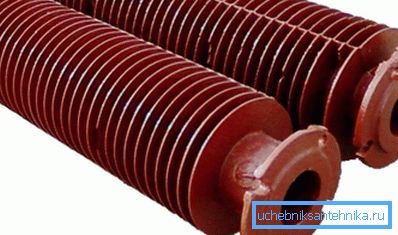
Useful: in the absence of paronite in water heating, it can be replaced with gaskets, cut out by hand from the car chamber. But when heating industrial premises with superheated steam, it will be necessary to look for exactly paronite: ordinary rubber at temperatures of 200-400 degrees will quickly begin to crumble.
Orientation
A typical industrial heating register is a horizontally oriented pipe. However, tubular steel heating radiators for residential premises are often vertical.
With the same overall dimensions and the same surface area, the heat output of the heating registers does not depend much on the orientation of the pipes.
The horizontal orientation of the majority of products is connected with rather mundane reasons:
- To create a thermal curtain in front of the window, the heater must be completely located under it, which implies a well-defined ratio of length and height.
- It is much simpler to weld a low and elongated register from horizontal pipes.
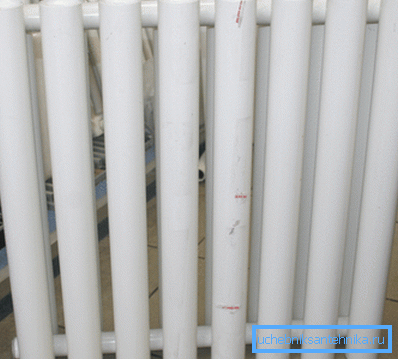
Jumpers
The shape and size of the jumpers registers are divided into sectional and S-shaped.
Instructions for making a register of the first category in brief looks like this:
- Large diameter pipes are cut into segments of the same length.
- Their ends are jammed with discs cut from steel sheet 3-4 millimeters thick.
- Holes for lintels and nozzles are cut in the walls of the pipes, after which they grab them and, after editing the register form, are scalded.
- The additional, deaf crossing points welded in, giving to a design rigidity.
The production of heating registers of this type is attractive because it requires a minimum of tools: a Bulgarian and a welding transformer are sufficient. The price of simplicity of design is a rather high hydraulic resistance of the device due to numerous diameter transitions.
S-shaped registers for heating are a coil of constant cross section, in which thinner jumpers are needed only for rigidity. For the manufacture of roundings with a small diameter pipes (up to 50 mm) is used pipe bender. For large sections it is necessary to acquire ready-made taps.
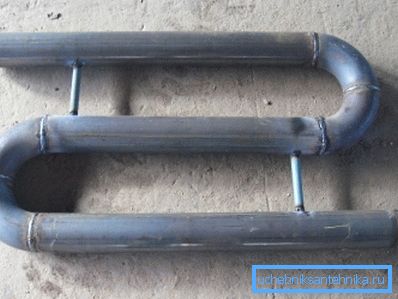
Special cases
Separately worth mentioning a couple of very curious designs.
Continuous register
At enterprises built in the 50-70s of the last century, instead of sectional or S-shaped registers, a rather curious construction is used: a shop or ancillary room is girded around the entire perimeter with an unbreakable pipe. The scheme is useful in that it provides heating of the walls with an ascending stream of warm air along their entire length.
Autonomous Register
As an autonomous heating device, a register is often used, at the end of the lower section of which one or several tubular electric heaters are installed.
The manufacture of the device has a few subtleties.
- Jumpers in it are made through at both ends of each section. This ensures the convection of the coolant.
- The device is made open. A part of its capacity is used as an expansion tank: the coolant fills the register only for 90-95% of the volume.
- As a coolant, it is often not water that is used, but oil (mining or cheap mineral), which allows us not to be afraid of defrosting.
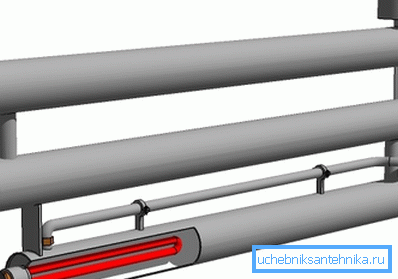
Installation
What is the installation of heating registers?
The simplest fastening of the register is on smooth reinforcement hammered into the wall with a diameter of 10-14 mm.
- The wall is marked by the level of several holes where the lower and upper sections should be located.
- Holes are drilled with a diameter less than half a millimeter less than the fittings you have.
Tip: since the drill with a diameter of, say, 11.5 mm is almost impossible to find, the hole can be drilled with a diameter of 10 mm and expanded with a 11.5 mm metal drill.
- Sections of rebar with chamfered are driven into the wall to a depth of at least 6-7 cm.
- On them the heating device is hung out.
- The armature is bent up, bending around the register section. For bending using the lever of the pipe segment.
- Excess fittings are cut off at the site; the end is rounded off with a file to avoid injury.

Calculations
What is the calculation of the register of heating? Let's start from afar.
What technical characteristics of the heater should be considered when choosing it?
- Operating pressure. In a welded register, it obviously exceeds the parameters of the central heating station and allows it to withstand any water hammer.
- Operating temperature It is easy to guess that there are no special restrictions either.
- Thermal power. It is selected depending on the volume of the room. Lack of heat power means it will be cold at home; excess - that will have to keep the windows open and endure drafts.
How is the heating register calculated for a steel round pipe of known diameter?
The following formula is valid here:
Q = Pi * Dn * L * k * Dt, where:
- Q - section heat flux in watts.
- Pi is the number pi taken to be 3.1415;
- DN - the outer diameter of the pipe in meters.
- L - section length in meters.
- k is the thermal conductivity coefficient of a steel pipe, taken to be 11.63 W / m2 * C.
- Dt is the temperature delta between the coolant and the air in the room.
Important point: the heat flow is calculated for one horizontal pipe in this way. In the multi-row register for all sections, except the first, an additional factor of 0.9 is used: they are in the upward flow of warm air from the first pipe, which reduces the temperature delta.
How to recalculate the diameter of the pipe specified by the seller in inches to the usual values? Here is the size matching table:
| Size in inches | DU (conditional pass) |
| one | 25 |
| 1 1/4 | 32 |
| 1 1/2 | 40 |
| 2 | 50 |
| 2 1/2 | 65 |
| 3 | 89 |
| four | 100 |
| five | 125 |
| 6 | 150 |
| eight | 200 |
Note: The remote control approximates the inside diameter. To obtain an external one, it is necessary to add twice the pipe wall thickness.
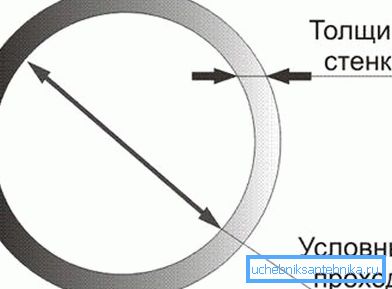
Let's estimate the heat transfer of a four-row register from a pipe with an outer diameter of 108 mm and a length of 1.2 meters at its temperature of +80 ° C and air temperature in the room +20 C.
- For the first section, the heat flux is 3.1415 * 0.108 * 1.2 * 11.63 * (80-20) = 284 watts.
- For each subsequent it is multiplied by 0.9. 284 * 0.9 = 255.
- The total value is 284+ (255 * 3) = 1049 watts.
Device evaluation
Let's try to give a brief assessment of the register.
- It is extremely durable and fault tolerant.
- Unlike sections with developed fins, it is easy to clean about dust.
- He practically does not need washing. While the coolant is circulating through the device, it will heat throughout the volume.
- Appearance - let's say, for an amateur. The register does not exactly decorate the room.
- Due to the lack of fins and low thermal conductivity of steel, the heat output of the register is significantly inferior to the aluminum radiator of the same dimensions.
findings
Registers should be used primarily for heating garages, workshops and industrial premises. For an apartment, you should look at more compact and decent-looking aluminum and bimetallic heating appliances.
As always, the attached video will offer the reader additional information. Successes!
